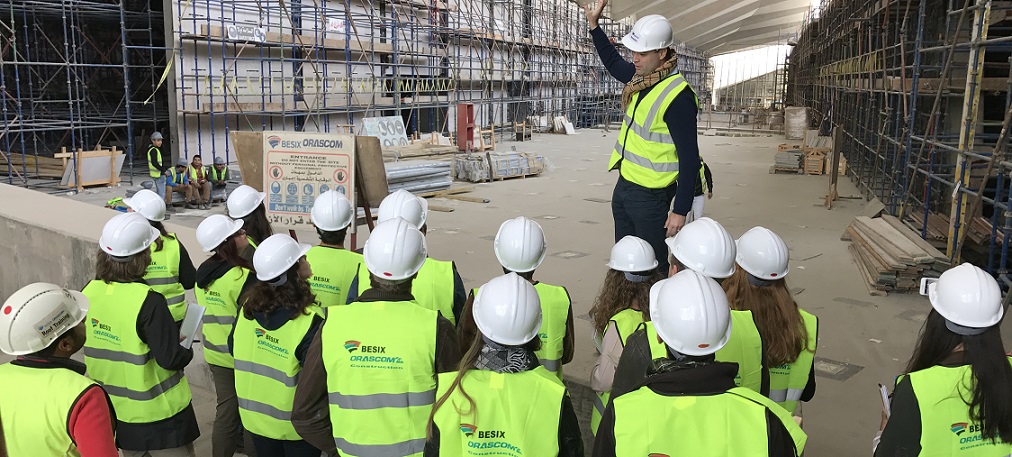Week 6: 12-18 February 2017
As the end of the program approaches, the sixth week of the Cairo Semester began with a trip to the Grand Egyptian Museum (GEM), which is still under construction. Our Sunday morning was first spent at the GEM Conservation Centre, where we learned about the goals of the GEM project and their plans for the future. We were also guided through a few of the conservation labs (organic materials, wood, and heavy-weight artifacts), where we could personally see some of the work being done by the Conservation Centre (mostly on Tutankhamun materials), and afterwards headed to the construction site. Here we were received by the Director of the GEM himself, Dr. Tarek Tawfik. After an interesting tour of one of the main galleries, which is still under construction but will be housing Tutankhamun’s complete funerary equipment by 2018, we went to CULTNAT, the Centre for Documentation of Cultural and Natural Heritage in Egypt. The visit to the CULTNAT was also extremely interesting, for we were introduced to several of their documentation projects, some still ongoing, including historical, archaeological, architectural and natural documentation of Egyptian heritage.
Monday took us to Ayn Sukhna, an archaeological site on the Red Sea coast. Ayn Sukhna was a harbor site in use during the Old and Middle Kingdoms, and a series of rock-cut galleries served as storage units for boats and other sailing materials, as well as any other objects related to the expeditions, such as pottery and tools of different materials. In one of these galleries, there was still a Middle Kingdom boat in situ – it had been set fire to, and the wood planks were now just charcoal, which was one of the reasons why they had survived to this day. We were given a very interesting tour of the archaeological site by director Claire Somaglino, and even a private lesson on ancient Egyptian metallurgic practices by one of the team members, on the ancient furnaces found on this site. After this wonderful tour, Claire invited us to have lunch with her and her team – our hungry selves could not have been happier!

On Tuesday the NVIC hosted a "study day", together with Cairo University: a few CU staff members gave lectures on their research in the morning, and afterwards we all had pizza for lunch. The lectures were extremely varied, and ranged from a contextualization of the site of Tell Zuwelen (by Nora Shawki), to an analysis of colour pigment used in Ancient Egypt through the ages (by Mona Hussein). The head of the Department of Egyptology at Cairo University, Ahmed Mekawy Ouda, also gave an interesting lecture on the goddess Werethekau, and our own Marleen De Meyer wrapped up the morning’s session with a talk on her beloved Dayr el-Bersha. This was a great opportunity for us to meet and mingle with the Egyptology students at Cairo University, as well as to exchange ideas and make new friends.
Wednesday was a self-study day. It appears that most of us went to either the German institute (DAIK) or the French institute (IFAO) to use their libraries and work on the research paper. In the evening, we had a lecture by Christiana Köhler at the ARCE. She is a professor at the University of Vienna, and talked about the recent archaeological work in Middle Egypt by her team. For the rest of the night, we were busy preparing for the progress report on the next day!

On Thursday afternoon, each of us gave a 10-minute presentation to report how much progress we have made so far on our papers. Everyone is still tackling their research questions, and has some minor issues, but all the topics sound very interesting. We are looking forward to our presentation day at the Egyptian Museum at the end of the semester and learning about other students’ research results! In the evening, Anna Stevens gave a lecture at the NVIC. She is the assistant director of the Amarna Project, and gave us a fascinating talk titled "Death and the City: the cemeteries of Amarna in their urban context."
Friday was a day off, but we continued to work on our paper. With the suggestions by our professor and other students in mind, hopefully everyone made some improvements!
On Saturday, we went out to explore Old Cairo. We took the metro from the Mugamma to get there. It was our first time to take metro in Egypt, and we had a surprisingly pleasant metro experience. Once we got off the train at Mar Girgis, some of us went to the Commonwealth Cemetery, and the American Cemetery. George Reisner, an American Egyptologist from Harvard University, is buried in the latter one. So, naturally two of us from Harvard had to pay a visit to his tomb! For the rest of the day, we were free to explore the area. Most of us went to the hanging church, Coptic museum, and the Mosque of Ibn Tulun, which is the oldest mosque in Cairo. Some of us also went to a souk and enjoyed shopping. In the evening, the Egyptian Exploration Society hosted a lecture "Where did it all go? Tracing the worldwide distribution of archaeological finds" by Alice Stevenson and Emma Libonati, both from the Petrie Museum of Egyptian Archaeology at UCL. They talked about their project to trace the distributions of the artifacts found during the official British excavations in Egypt from the 1880s to the 1980s. The artifacts have been distributed all over the world, and it was surprising to learn that some objects ended up in countries like Japan and Ghana.
The last week is already in sight. Stay tuned!
Inês Torres & Hilo Sugita


